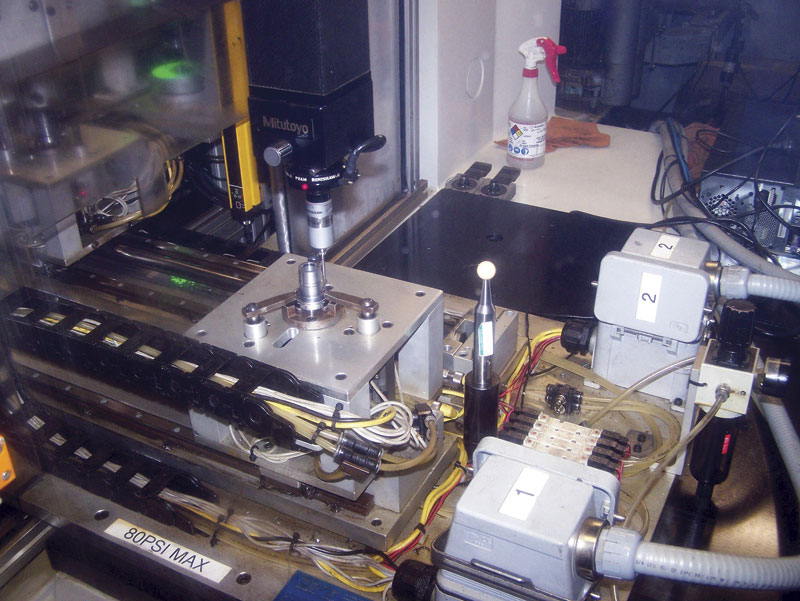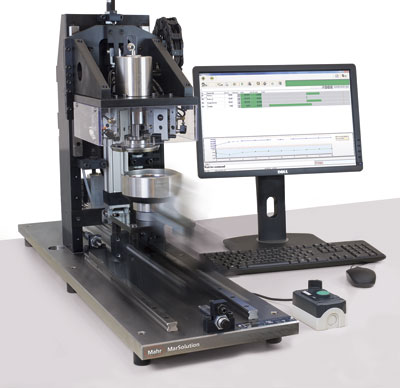by Andrew Brooks
Automating inspection processes raises the bar for product quality
The reasons for automating 3D inspection aren’t hard to fathom. Like CNC machining, automated inspection is faster, eliminates or reduces error-prone human intervention, and promises greater accuracy. The adoption of CNC technologies throughout the manufacturing process also makes it possible to link digitally generated measurement data directly back into the machining process.
“The number one reason people want to do quality control or 3D measurement using a robot or an automated process is mainly for quality control, first of all,” says Jérôme-Alexandre Lavoie, product manager for automated products at Montréal-based Creaform.
But for Lavoie, the motives go deeper than that. He believes the concept of quality control is being superseded by the more demanding notion of quality assurance, where product quality isn’t simply monitored and corrected as defects appear, but can be virtually guaranteed to be defect-free at an unprecedentedly low scrap rate. Instead of a reactive process where product faults are detected post-production and the problems are fixed at that point, problems can be detected when the first signs of deviation are just beginning to appear, even before products are actually out of tolerance.
“Instead of measuring one part out of 50, one out of 100, people want to be able to measure 100 per cent of every part,” Lavoie says. “Then, if there’s a trend that could potentially over time lead to a nonconformity, instead of discovering that nonconformity after 100 or 1000 parts or more have been manufactured, you can discover it right away.”
 Another factor may be labour-related, says George Schuetz, director of precision gages for Mahr Federal. And he doesn’t mean simply eliminating human operators wherever possible. “I think trying to find skilled labour is probably hard these days. The pool of skilled labour is diminished, so they want to find a way to automate so they don’t have to rely on that skilled labour. And even when they do find those skilled people, the cost is probably pretty high, which is a problem when reducing cost is an issue.”
Another factor may be labour-related, says George Schuetz, director of precision gages for Mahr Federal. And he doesn’t mean simply eliminating human operators wherever possible. “I think trying to find skilled labour is probably hard these days. The pool of skilled labour is diminished, so they want to find a way to automate so they don’t have to rely on that skilled labour. And even when they do find those skilled people, the cost is probably pretty high, which is a problem when reducing cost is an issue.”
Peter Detmers, executive vice president of Mitutoyo Canada, illustrates the benefit of automation with the example of a cutting tool, which experiences wear every time it contacts the cut material. The effects of wear can show up in a variety of ways, whether it’s surface finish, dimension, or some other parameter. In a non-automated environment, where inspection occurs on every tenth or hundredth part, or even less frequently, it will take a longer time for the effects of wear to become apparent than it would if every part can be inspected and that data automatically logged and analyzed. An automated inspection system cuts that detection time down to near zero.
“As you’re looking at the data in real time and getting a higher frequency of data–for instance on the diameter of a bore–you can see the subtle changes,” Detmers says. “If you’re just inspecting, say, 10 random parts an hour, you’ll see the changes too, but over a longer time frame. Sure, you can look at the accumulated history and chart it and notice the pattern. But by the time you’ve done all that work, you’re well into your production run. Maybe you’ve already changed the tooling.”
The difference with true machine-to-machine automation is that even very subtle changes in measurement can be detected immediately–and acted upon just as quickly. The operator can easily offset a value in the controller so the machine changes where it’s cutting. As the tool wears, the cut profile can be altered to compensate. Of course the tool eventually has to be changed out, but only after its useful life has been lengthened for as long as possible.
Without automation, tools are of course still monitored for wear and changed out as required, but the interval is usually based on a fixed change-out schedule. “Somebody’s going to change the tool because that’s just what you do every three hours or whatever, because the life cycle has been estimated based on past observations,” Detmers says.
“But if you’re actually monitoring it closely, you’re not going to run into those problems because you’re going to change the tools before problems occur.” If automation is intensive enough, there isn’t any need for operator intervention at all and corrections are made automatically via a machine-to-machine interface.
Glueckler Metal Inc. (GMI) was an early entrant in the field of automated inspection. The precision machining shop, with two facilities in Barrie and Elmvale, ON, elected to fully automate the measurement operations associated with a ten-machine cell in 2005. Mitutoyo Canada was just introducing CMM models that were designed to cope with the rugged conditions on the shop floor, and GMI chose the company’s Mach-V to do the measuring.
The machine cell incorporated ten multi-axis Nakamura-Tome turning machines, and the Mach-V was served by a robotic loader/unloader. The line produces one part every ten seconds, so 100 per cent inspection wasn’t possible, even with all the automation. Instead, the CMM inspects about one part in five, though the exact frequency varies depending on the complexity of the part.
“We have various types of cells, but this was the largest that we had done to date,” says company president Anthony Glueckler. “It was set up on its own coolant system, scrap system, robotics, packaging, everything. At the time CMMs were usually held in some form of controlled atmosphere room. Most if not all customers would have it in a separate room where humidity, temperature, vibration, noise, all of that would be controlled.”
 One sign of just how ahead of its time this implementation was–“I think we were the first in Canada, if not North America, to have this system,” Glueckler says–is that the software was developed during the process, and that university researchers were involved.
One sign of just how ahead of its time this implementation was–“I think we were the first in Canada, if not North America, to have this system,” Glueckler says–is that the software was developed during the process, and that university researchers were involved.
“We had an integrator use a programmable logic controller and various other controls to take software that was derived from a three-way collaboration between ourselves, Mitutoyo and McMaster University, and integrate the machine tool and the CMM,” Glueckler says.
The advantages of automation this extensive start with the faster measurement, greater accuracy and elimination of operator error noted earlier, but it turns out one of the main pluses for GMI was simple physical proximity.
“What was really key for us was bringing the CMM out to the floor, to the machines, and having a process that was totally automated,” Glueckler says. “It enabled us to take that information, the data that was being derived through the CMM, out onto the floor and put it directly back to the machine tool without any operator interference or requirement. In essence it allowed us to have a machine talk to a machine to make offsets and control the process in real time.”
Ten years later the cell is still functioning as it did when it was set up, 24 hours a day, most days of the year. “This thing shuts down very, very little. It’s very robust–the machine tools in the process, the scrap system, the cooling system, all of this is still very robust 10 years into operation. We’re still producing very good results on tightly dimensioned components.”
GMI produces to 20 micron tolerances, but as Glueckler says, in practice they’re usually working at about half that. When GMI set up the automated cell ten years ago, the scrap rate on manual processes was around five per cent. The automated system brought that down to around 1.5 per cent. That may be an industry standard, but it’s a remarkable achievement given the demanding standards GMI works to.
 “It may not sound very impressive,” Glueckler says. “But when you think of the tolerances we are holding on millions of pieces… this cell is built to generate about two and a half million units per year. We’re holding about 10 key tolerances on each one of these parts. Bear in mind that last year we produced about 35 million units in both facilities, and you can’t be wrong once on these parts. Zero defects is the game.”
“It may not sound very impressive,” Glueckler says. “But when you think of the tolerances we are holding on millions of pieces… this cell is built to generate about two and a half million units per year. We’re holding about 10 key tolerances on each one of these parts. Bear in mind that last year we produced about 35 million units in both facilities, and you can’t be wrong once on these parts. Zero defects is the game.”
As Glueckler says, if you multiply 10 tolerances times 30 million parts, GMI has to be right 300 million times a year. With automation, he says, “that is taken out of the space of the operator, which is where most of the errors would occur. It’s not that the operator isn’t technically sound or not trying hard enough. It’s basically beyond human capability to comprehend.”
Transcending the bounds of human capability can be a complex process, and shops have to do their homework when selecting an automation partner. “Each level of integration becomes a little more complex,” Detmers says. “Even a 100-person shop with lots of well trained people, if they’re doing robotics, number one they’re going to need to find someone who understands PLC communications, understands robotics.”
Automation has become commoditized to the point that it’s financially feasible to attach a sophisticated CNC CMM to a machine tool, whereas in the past the cost of the CMM would be prohibitive. But there’s no getting around the fact that automation can still require a sizeable outlay.
“There’s always financial risk–for everybody,” Detmers says. “You have to make sure the partner you work with is financially stable, because with automation there’s always a risk, not only for the person who’s procuring it, but also for the people who are providing it.” SMT
